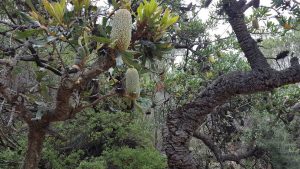Urbanisation is a prominent and increasing form of land-use change, with the potential to disrupt the interactions between pollinators such as bees and the flowering plants that they visit.

This in turn may cause cascading local extinctions and have consequences for pollination services. Towns and cities are ecologically complex environments where nature finds a home in all sorts of places, including both highly artificial gardens created by people, and the fragments of natural environment left behind when developments are built. A new study co-authored by Jeff Ollerton and Kit Prendergast compared and contrasted the pollinators, and the plants that they visit, in urban settings in the biodiversity hotspot of Western Australia.
The study highlights just how different gardens are to remnant natural vegetation. If we are to maintain the maximum possible pollinator diversity, and associated pollination services, we need to retain as much remnant vegetation as possible when designing and building new developments. Gardens alone are not enough.
Read more here: https://bit.ly/3cw6LX5
